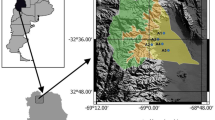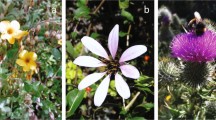Abstract
Populations of the mangrove Avicennia marina in the Sydney region exist as stands of varying size, reflecting both natural and anthropogenic fragmentation. We hypothesised that, as observed in many terrestrial forests, small stands (<100 plants) would experience lower pollinator densities and altered pollinator behaviour and visitation and, in consequence, would display reduced pollen deposition as compared with large stands (>10,000 plants). Nevertheless, we recognise that such predictions may be overly simplistic because within this region A. marina attracts a diversity of flower visitors, but its only significant pollinator is the exotic honeybee Apis mellifera. Moreover, it is unclear how readily A. mellifera moves among groups of plants within different mangrove stands of varying sizes separated either by water or urban habitat matrix. Our detailed surveys within pairs of large and small stands in two locations support the predictions that pollinator density and pollen deposition are reduced or altered within small stands. Within small stands honeybee abundance and pollen deposition were on average reduced significantly by 84 and 61 %, respectively. Moreover, within small stands there was a non-significant 12 % increase in the mean time that honeybees spent foraging on individual plants and hence potentially depositing self pollen. Taken together, our data indicate that fragmentation affects the performance of A. mellifera as a pollinator of A. marina and reduce pollinator abundance, leading to pollen limitation in small as compared to large stands, which may negatively affect reproductive output.





Similar content being viewed by others
References
Aguilar R, Ashworth L, Galetto L, Aizen MA (2006) Plant reproductive susceptibility to habitat fragmentation: review and synthesis through a meta-analysis. Ecol Lett 9:968–980
Aguirre A, Dirzo R (2008) Effects of fragmentation on pollinator abundance and fruit set of an abundant understory palm in a Mexican tropical forest. Biol Conserv 141(2):375–384
Aizen MA (1998) Forest fragmentation and plant reproduction: the pollination link. In: Bruns S, Mantell S, Tragardh C (eds) Recent advances in biotechnology for tree conservation and management. IFS, Stockholm, pp 22–37
Aizen MA, Feinsinger P (1994) Habitat fragmentation, native insect pollinators, and feral honey bees in Argentine “Chaco Serrano”. Ecol Appl 4:378–392
Aizen MA, Ashworth L, Leonardo G (2002) Reproductive success in fragmented habitats: do compatibility systems and pollination specialization matter? J Veg Sci 13:885–892
Bierzychudek P (1981) Pollen limitation of plant reproductive success. Am Nat 107:360–369
Bradshaw GA, Marquet PA (2003) How landscapes change: human disturbance and ecosystem fragmentation in the Americas. Springer-Verlag, Berlin
Burd M (1994) Batemans principal and plant reproduction: the role of pollen limitation in fruit and seed set. Bot Rev 60:83–139
Butz Huryn VM (1995) Use of native New Zealand plants by honey bees (Apis mellifera L): a review. N Z J Bot 33(4):497–512
Cane JH (2001) Habitat fragmentation and native bees: a premature verdict? Conserv Ecol 5:3
Cascante A, Quesada M, Lobo JA, Fuchs EJ (2002) Effects of dry tropical forest fragmentation on the reproductive success and genetic structure of the tree, Samanea saman. Conserv Biol 16:137–147
Chanyenga T, Geldenhuys C, Sileshi G (2011) Effect of population size, tree diameter and crown position on viable seed output per cone of the tropical conifer Widdringtonia whytei in Malawi. J Trop Ecol 27:515–520
Clarke PJ, Myerscough PJ (1991) Floral biology and reproductive phenology of Avicennia marina in Southeastern Australia. Aust J Bot 39:283–293
Collinge SK (2009) Ecology of fragmented landscapes. Johns Hopkins University Press, Boltimore
Duke NC (1990) Phenological trends with latitude in the mangrove tree Avicennia marina. J Ecol 78:113–133
Duke NC (2006) Australia’s mangroves: the authoritative guide to Australia’s mangrove plants. University of Queensland, Brisbane
Ghazoul J (2005) Pollen and seed dispersal among dispersed plants. Biol Rev 80(3):413–443
Hermansen TD (2013) Reproductive biology and genetic structure in fragmented populations of the temperate mangrove Avicennia marina. Dissertation, University of Wollongong, Australia
Hermansen TD, Britton DR, Ayre DJ, Minchinton TE (2014) Identifying the real pollinators? Exotic honeybees are the dominant flower visitors and only effective pollinators of Avicennia marina in Australian temperate mangroves. Estuar Coast 37(3):621–635
Homer L (2009) Population structure and distance of gene flow in Avicennia marina (Forsk.) Vierh. (Avicenniaceae) on a local/regional scale in the Northern Rivers of New South Wales, Australia. Dissertation, Southern Cross University
Jennersten O (1988) Pollination in Dianthus deltoides (Caryophyllaceae): effects of habitat fragmentation on visitation and seed set. Conserv Biol 2:359–366
Lihoreau M, Raine NE, Reynolds AM, Stelzer RP, Lim KS, Smith AD, Osborne JL, Chittka L (2012) Radar tracking and motion-sensitive cameras on flowers reveal the development of pollinator multi- destination routes over large spatial scales. PLOS Biol 10(9):e1001392
Lomov B, Keith DA, Hochuli DF (2010) Pollination and plant reproductive success in restored urban landscapes dominated by a pervasive exotic pollinator. Landsc Urban Plan 96:232–239
Murcia C (1996) Forest fragmentation and the pollination of Neotropical plants. In: Schelhas J, Greenberg R (eds) Forest patches tropical landscapes. Island Press, Covelo, pp 19–36
Nayak KG, Davidar P (2010) Pollinator limitation and the effect of breeding systems on plant reproduction in forest fragments. Acta Oecol 36:191–196
Newman BJ, Ladd P, Brundrett M, Dixon KW (2013) Effects of habitat fragmentation on plant reproductive success and population viability at the landscape and habitat scale. Biol Conserv 159:16–23
Pahl M, Zhu H, Tautz J, Zhang S (2011) Large scale homing in honeybees. PLOS One 6(5):e19669
Paton DC (1993) Honey-bees in the Australian environment. Does Apis mellifera disrupt or benefit the native biota? Bioscience 43:95–103
Paton DC (1996) Overview of feral and managed honeybees in Australia: distribution, abundance, extent of interactions with native biota, evidence of impacts and future research. Department of Zoology, The University of Adelaide, prepared for the Australian Nature Conservation Agency, pp 1–63
Sih A, Baltus MS (1987) Patch size, pollinator behavior, and pollinator limitation in Catnip. Ecology 68:1679–1690
Simpson MG (2006) Plant systematics. Elsevier Academic Press, USA
Steffan-Dewenter I, Tscharntke T (1999) Effects of habitat isolation on pollinator communities and seed set. Oecologia 121(3):432–440
Steffan-Dewenter I, Münzenberg U, Bürger C, Thies C, Tscharntke T (2002) Scale-dependent effects of landscape context on three pollinator guilds. Ecology 83(5):1421–1432
Ward M, Johnson SD (2005) Pollen limitation and demographic structure in small fragmented populations of Brunsvigia radulosa (Amaryllidaceae). Oikos 188(2):253–262
Whelan RJ, Ayre DJ, Beynon FM (2009) The birds and the bees: pollinator behaviour and variation in the mating system of the rare shrub Grevillea macleayana. Ann Bot 103(9):1395–1401
Young A, Pickup M (2010) Low S-allele numbers limit mate availability, reduce seed set and skew fitness in small populations of a self-incompatible plant. J Appl Ecol 47(3):541–548
Acknowledgments
We thank Ben Beverly for skilled field assistance during the A. marina flowering season of 2009. This study was supported by a UoW postgraduate scholarship to Tyge D. Hermansen, by an ARC Discovery Grant to Todd E. Minchinton and David J. Ayre and by the University of Wollongong’s Institute for Conservation Biology and Environmental Management.
Author information
Authors and Affiliations
Corresponding author
Additional information
Communicated by G. Wardle.
Rights and permissions
About this article
Cite this article
Hermansen, T.D., Ayre, D.J. & Minchinton, T.E. Effects of stand size on pollination in temperate populations of the mangrove Avicennia marina . Plant Ecol 215, 1153–1162 (2014). https://doi.org/10.1007/s11258-014-0374-3
Received:
Accepted:
Published:
Issue Date:
DOI: https://doi.org/10.1007/s11258-014-0374-3




